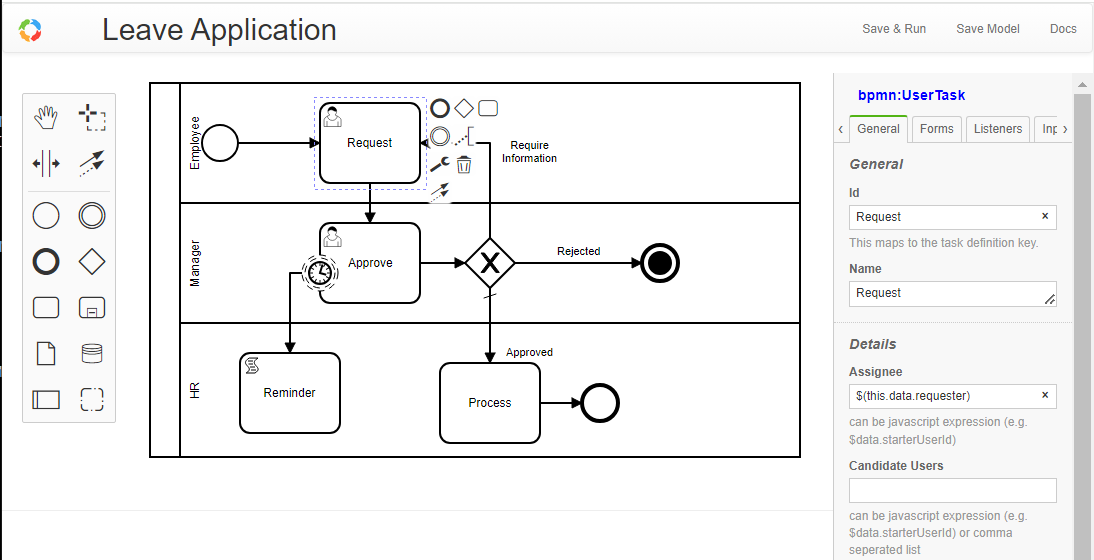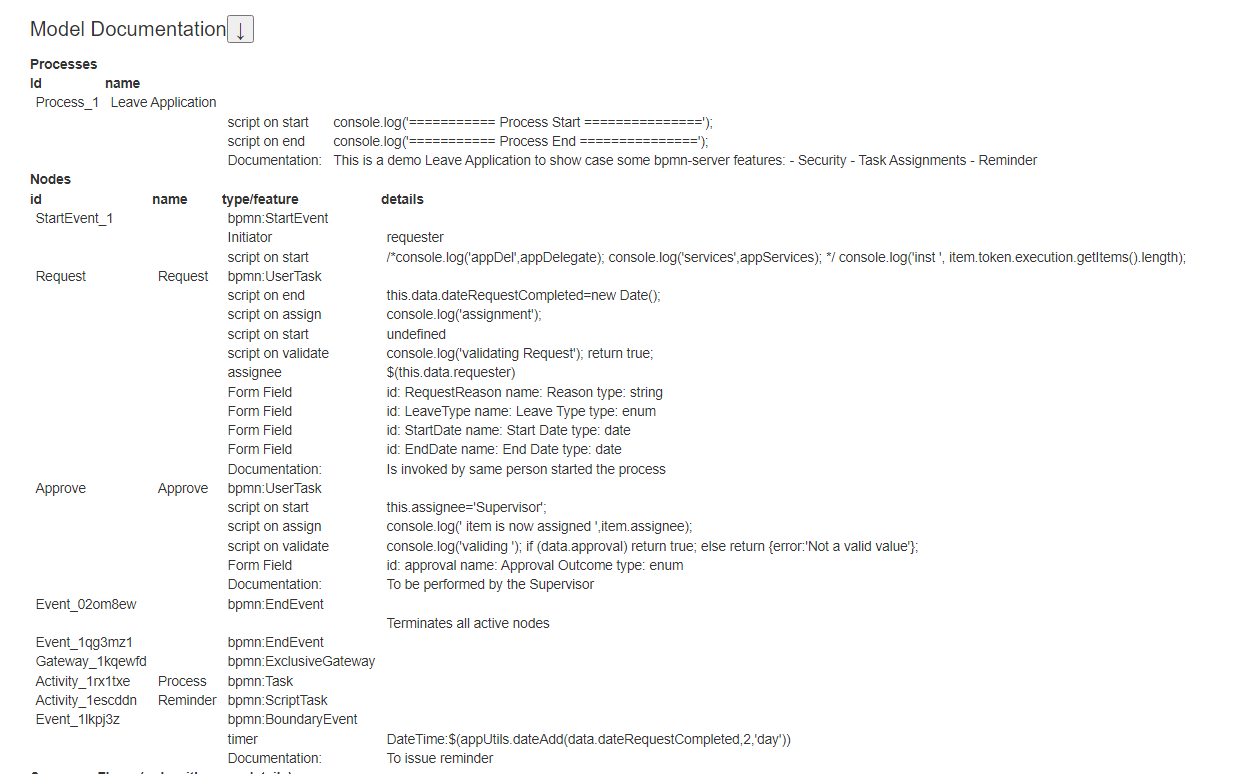bpmn-server is a BPMN-based workflow engine that integrates easily into your Node.js app. It supports built-in state persistence, variable management, and concurrency across clusters—ideal for long-running processes, durable services, and scheduled tasks.
The following diagram illustrates the core components of bpmn-server and how they interact:
- Modeler: Front-end UI for designing BPMN models using bpmn.io.
- bpmn-server Core: Executes BPMN workflows, manages state, and interfaces with external services.
- Datastore: Persists workflow state, variables, and history (MongoDB by default).
- Application Layer: Your Node.js app that integrates with the server, handles user authentication, and invokes workflows.
# 1. Clone the demo app
$ git clone https://github.com/bpmnServer/bpmn-web.git
$ cd bpmn-web
# 2. Install dependencies
$ npm install
# 3. Run setup to create default install files
$ npm run setup
# 4. Edit `.env` file.
# 5. Run setup to create database and models
$ npm run setup
# 6. Start the server
$ npm run startOpen your browser to http://localhost:3000 to launch the demo.
const { BPMNServer, DefaultAppDelegate } = require('bpmn-server');
const { configuration } = require('./configuration');
const server = new BPMNServer(configuration, new DefaultAppDelegate());
const processName = 'invoice';
const inputData = { amount: 1200 };
(async () => {
const result = await server.engine.start(processName, inputData);
console.log('Process started with instance id:', result.instance.id);
})();For more advanced examples, see the API documentation.
bpmn-server provides a modeling tool based on bpmn.io with a customized property panel, eliminating the need to manually edit BPMN files.
You can also import BPMN models from other tools.
Each model is defined in a BPMN XML file and consists of various elements. An element can be a node (such as events, tasks, or gateways) or a flow.
Models are managed by bpmn-server and can be queried using the Model API.
All BPMN 2.0 elements are supported. See Modeling Support
bpmn-server is primarily an execution engine for BPMN models.
Each time a model is started, an instance is created. For every element that is executed, an item is generated.
Execution follows the BPMN model logic and supports extensions such as scripting and application context access.
During execution, both Model Listeners and Application Listeners are invoked.
Access the execution engine via the Engine API.
Execution data, including instances and their elements, are persisted to a datastore (MongoDB by default).
You can query this data through the Data API.
bpmn-server delegates authentication to the front-end application, which must pass user information via the API.
- Model designers can define
assignee,candidateUsers, andcandidateUserGroupsusing static strings or JavaScript expressions. - The front-end must provide a
userServiceimplementation. -
bpmn-serverenforces security rules based on the current user.
The bpmn-web demo application demonstrates full user management using Passport and MongoDB.
Explore the `bpmn-web` demo application.
Features include:
- Persistent modeling tool (based on
bpmn.io) - Property panel supporting all
bpmn-serverfeatures - Execution with input forms for defined fields
- Task and workflow lists
- Instance detail view
- Model specification viewer
A live demo is available at: https://bpmn.omniworkflow.com
This package requires Node.js and MongoDB.
If MongoDB is not installed, you can create a free cloud account or install it locally.
git clone https://github.com/bpmnServer/bpmn-web.gitnpm installnpm run setupEdit the .env file to configure MongoDB:
MONGO_DB_URL=mongodb://0.0.0.0:27017/bpmnRun setup again to create DB objects:
npm run setupnpm run startConsole output:
bpmn-server WebApp.ts version 1.4.0
MongoDB URL mongodb://0.0.0.0:27017/bpmn
db connection open
App is running at http://localhost:3000 in development mode
Press CTRL-C to stop
Install `bpmn-server` and dependencies with Docker.
version: "3.7"
name: bpmn-server
services:
bpmn-web:
image: ralphhanna/bpmn-web
command: sh -c "
npm run setup &&
npm run start"
ports:
- 3000:3000
volumes:
- 'app:/app'
depends_on:
- mongo
mongo:
image: mongo
ports:
- 27017:27017
volumes:
- mongodb:/data/db
volumes:
mongodb:
driver: local
driver_opts:
type: 'none'
o: 'bind'
device: './mongodb_volume'
app:
driver: local
driver_opts:
type: 'none'
o: 'bind'
device: './bpmn_server_volume'docker compose up -dUse `bpmn-server` via CLI for common operations.
npm run cli
server started..
Commands:
q quit
s start process
lo list outstanding items
li list items
l list instances for a process
di display instance information
i invoke task
sgl signal task
msg message task
d delete instances
lm list models
lme list model elements
ck check locked instances
re recover hung processes
lu list users
spw set user password
? show this help menunpm update bpmn-serverbpmn-server is designed to be embedded into your application. See customization guide
- Invoking Workflows
- Execution
- Scripting
- Security
- Data
- Examples
- API Summary
- API Reference
- Setup
- Application Integration
Licensed under the MIT License.
bpmn-server builds upon bpmn-io/bpmn-moddle by bpmn.io, and is inspired by bpmn-engine.





